![]() a sculptor
a sculptor
 JP | EN
JP | EN
 JP | EN
JP | EN

When I saw things in front of me falling down, I began to think that instead of things that have shape, I want to create things that do not have shape. I felt the strength of the force of nature, and I also had the realization of becoming a parent, which was something I’d never experienced before, and these facts changed my values.
 Photo: The bank passbook of Donguri Bank Kobe, which looks just like a real bank passbook
Photo: The bank passbook of Donguri Bank Kobe, which looks just like a real bank passbookOn that day, I was reading into the early hours on the first floor, and a large quake came just as I left the room. When I looked at my house after it became light enough, I was filled with a sense of dread. Everyone said to me, “the child in you must have saved you.”
My belly was becoming larger every day, and just going to work was a real effort. But it was wonderful how it became common to interact with our neighbors, which is something we hardly did before.
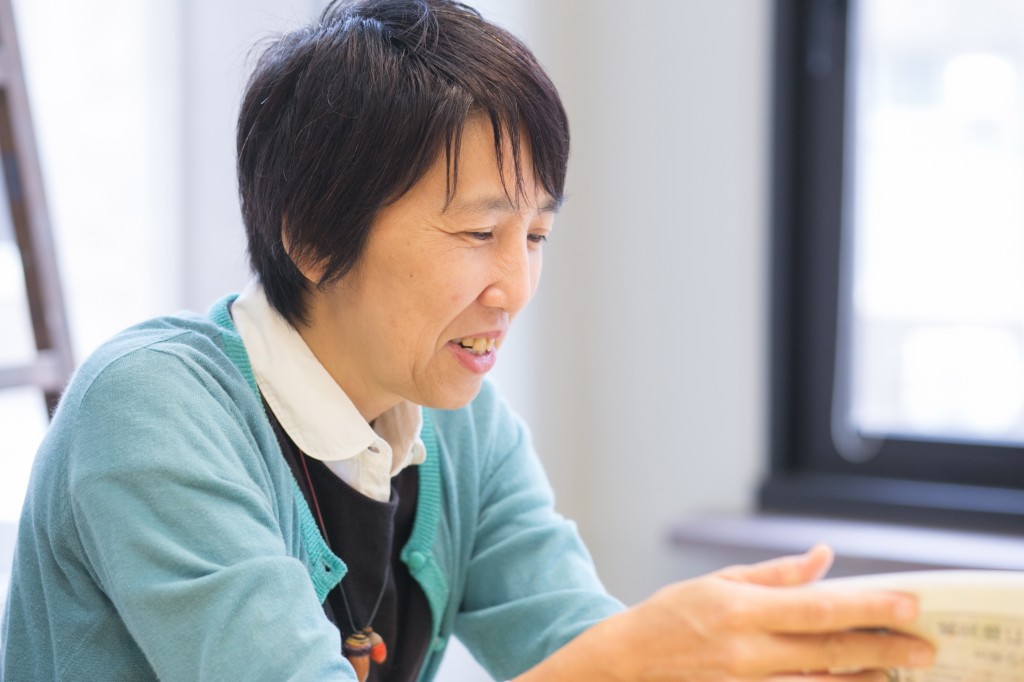
I saw it being introduced on TV, and I thought, “This is it!” Immediately after the earthquake, I saw sights where only the trees around the houses remained standing. In the spring, while the city still had much debris, there were new buds growing. And yet, the trees were cut down as part of the recovery effort, and that pained me.
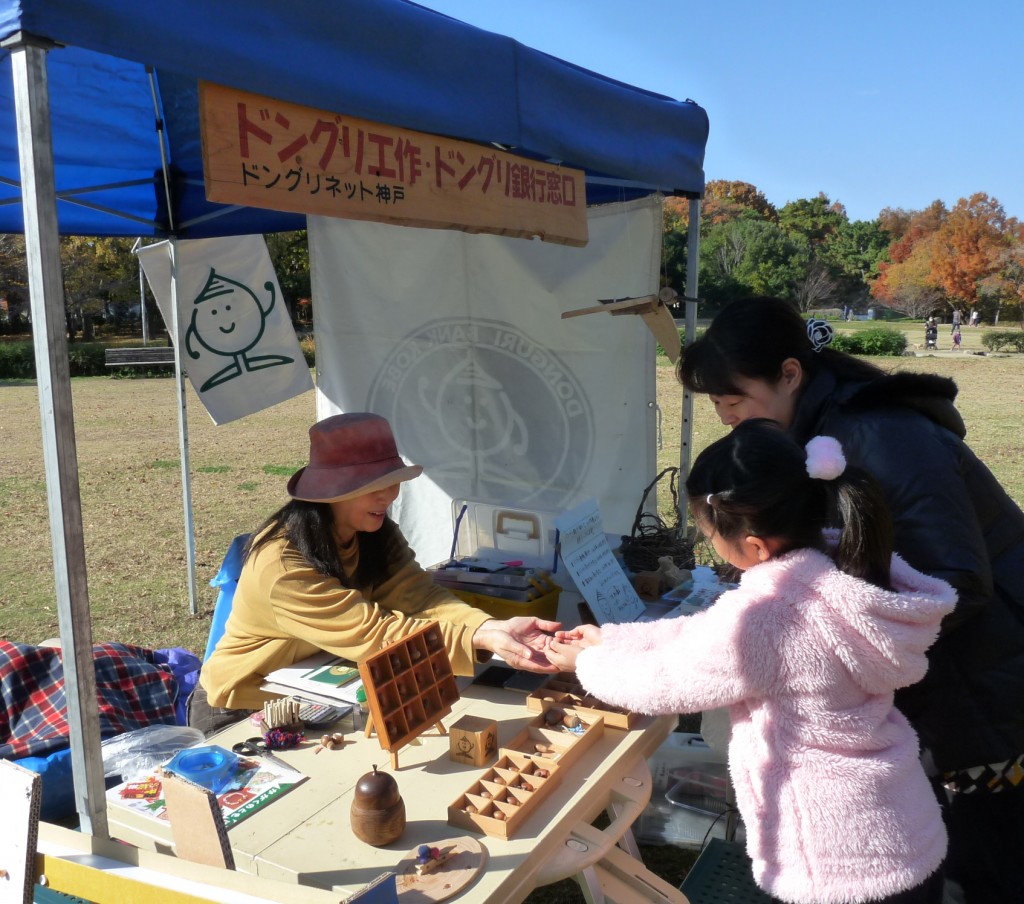 Photo: Reception at Donguri Bank Kobe, exchanging collected acorns with seedlings
Photo: Reception at Donguri Bank Kobe, exchanging collected acorns with seedlings Photo: One of the appeals of acorns is that unexpectedly, there are a large variety of different types.
Photo: One of the appeals of acorns is that unexpectedly, there are a large variety of different types.Osamu Nakanishi, the Vice President of Donguri Net Kobe, is doing research on plant ecology. He is so well informed about acorns that he can discern the type of acorn just by looking at the leaf or the shape of the acorn cup. We hit it off as soon as we met, and I became the one to start things by proposing fun plans, and he became the acorn professor who specializes on plants. I think this is a great partnership.
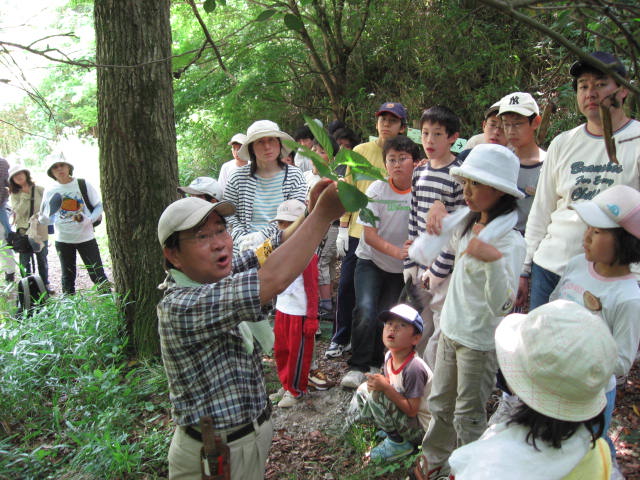 Photo: Class on the environment with the acorn professor, Osamu Nakanishi
Photo: Class on the environment with the acorn professor, Osamu NakanishiAs I was trying to go about with the activities, at a loss as to even finding out how to grow them, there were many projects that I was able to actualize from having met many different people of various ages and occupations. Our final goal is to create a forest in the city of Kobe. It is also important to help form a bond between various individuals, and I asked people to try to increase greenery in their own home gardens.
Nursery owners said they would provide us with seedlings that could not be sold on the market. And almost 100% of seedlings other than acorns were grown with care and transported all the way to Kobe by Toshiharu Kamezaki in Gifu Prefecture.
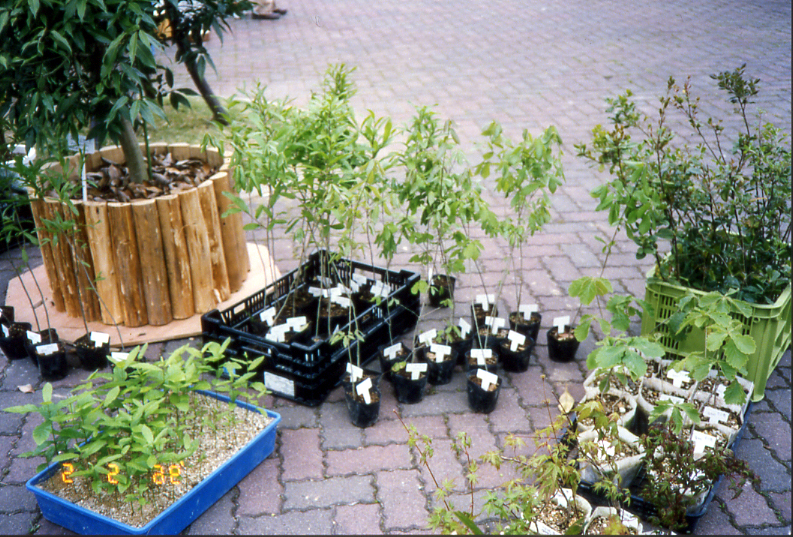 Photo: Numerous seedlings gathered by the cooperation of Plant Masters
Photo: Numerous seedlings gathered by the cooperation of Plant MastersWe made Mount Oraga, on the Western end of the Rokko Mountain Range, as the site for our activities, and held events such as the Donguri Picnic. We created a cycle of “picking up acorns, having fun, growing them, and planting them,” and started increasing trees on a mountain that didn’t have many greens. This activity continued for seven and a half years, and now, the mountain is flourishing with trees.
The objective is to increase greenery, so after a day of playing with acorns, we place importance on being sure that at least one acorn is planted by the participants, either at the event location or at their home. It’s really moving to see a sprout emerging from an acorn, and I want everyone to see it.
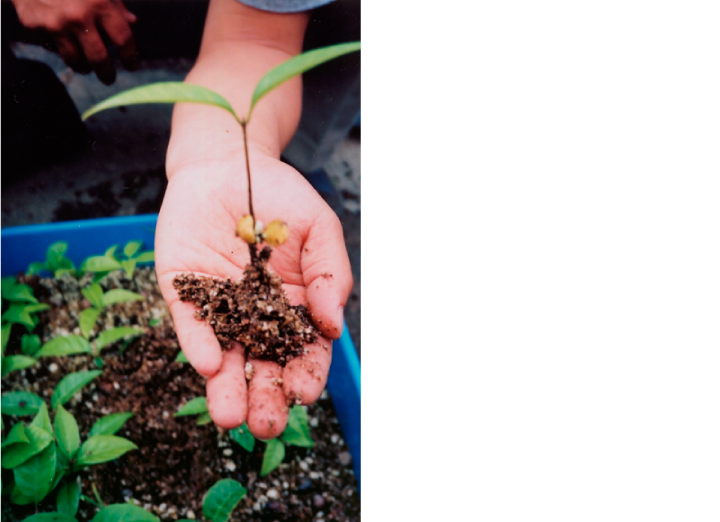 Photo: An acorn that has just sprouted, which there are not many opportunities to see
Photo: An acorn that has just sprouted, which there are not many opportunities to seeIt made me really happy when a child who participated many times said, “This is the mountain that I brought up!” If they think they are actually growing it, then I think we can change their awareness of nature. The ideal way to do things is to let them have fun, and then have them suddenly realize that there is more nature around them!
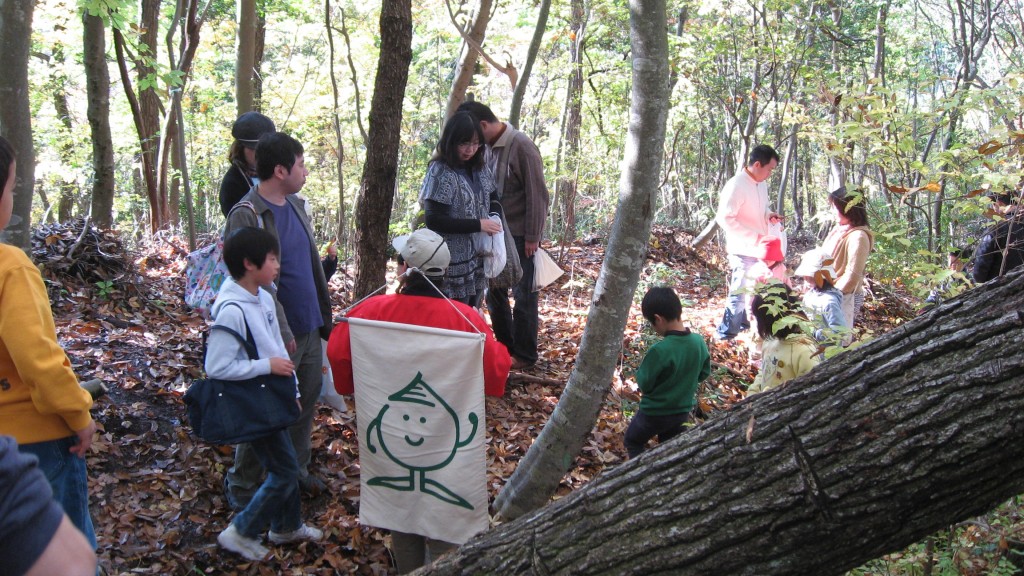 Photo: Donguri Observation Tour at Mount Futatabi in Chuo Ward of Kobe City
Photo: Donguri Observation Tour at Mount Futatabi in Chuo Ward of Kobe CityFour years before the opening of the park, I explained our objective to the people who came to the Gathering to Remember the 1.17 Great Hanshin-Awaji Earthquake, and distributed acorns. In March 2008, we held a tree planting session for the first time, and an unbelievable number of people came out to plant the saplings that they had nurtured in their own gardens.
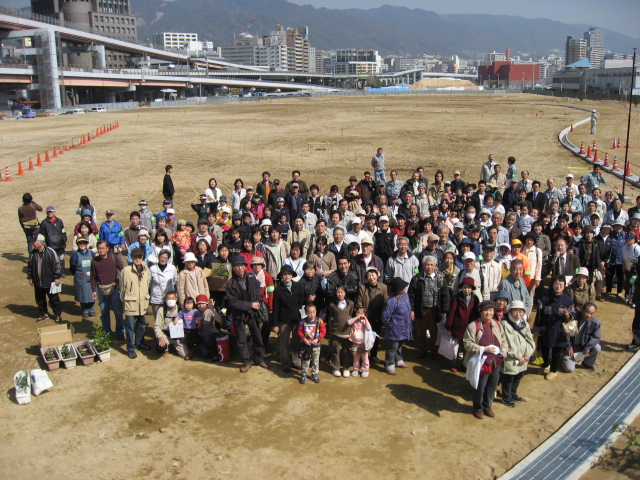 Photo: Many people brought saplings to the Midori no Mori Park, which still did not have any plants. This was a commemorative day in which efforts towards creating forests started.
Photo: Many people brought saplings to the Midori no Mori Park, which still did not have any plants. This was a commemorative day in which efforts towards creating forests started.When the park first opened, the trees were still small and didn’t look like a forest, but now, the trees produce acorn seeds, and have grown so much that the trees need to be thinned. The good point about Donguri Bank Kobe is that instead of having a forest that is already there, we work together to grow and create a forest.
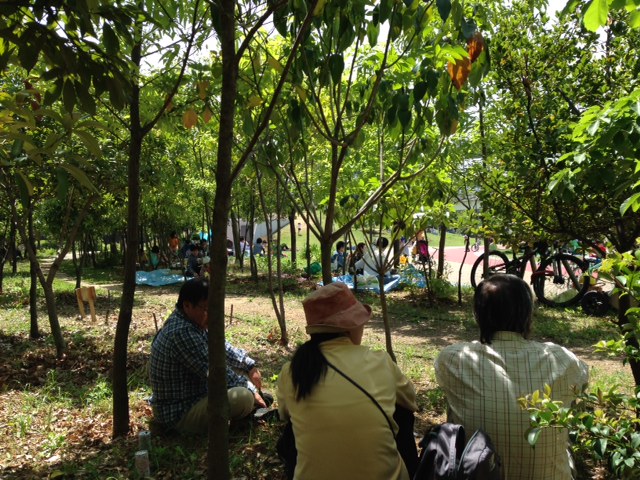 Photo: Minato no Mori Park, with the trees having grown large and looking truly like a forest
Photo: Minato no Mori Park, with the trees having grown large and looking truly like a forestI thought that this was a good time, now that our activities have continued for 20 years, and our trees are growing in various places. If we make Minato no Mori Park as the focal site for our activities, we can continue to protect our theme of creating forests in the city of Kobe.
We are thinking of new events to keep us from becoming just another greening project, now that we no longer have Donguri Bank as our crowning name. I am thinking about this very positively, believing that we will be able to broaden our activities even more freely, such as observing other varieties of trees or making something.
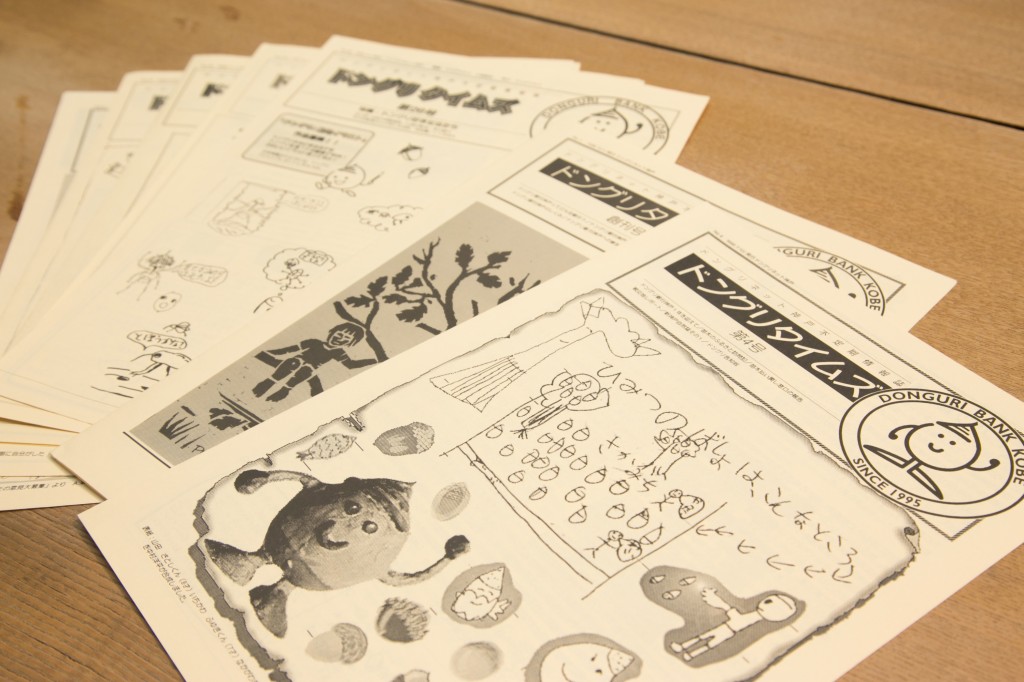 Photo: A heartwarming, handmade informational paper that provides information on activities conducted by Donguri Net Kobe
Photo: A heartwarming, handmade informational paper that provides information on activities conducted by Donguri Net KobeThere aren’t many cities that are so close to nature, so I think this is a treasure of Kobe. In particular, the people of Higashinada Ward and Nada Ward live close to Mount Rokko, so they may have more opportunities to think about the city and its greenery and nature as a matter of course within their daily lives.
Through the tree-planting activities that we have conducted so far, I wished to plant trees in the hearts of the children. It would make me happy if it becomes matter-of-fact that people and forests live in harmony, and if people remember, even just a little bit, that in their childhood, they planted acorns and played with acorns.
Makiko Masuda
Sculptor, and President of Donguri Net Kobe. Has been presenting three-dimensional works as a sculptor since 1982. In 1995, with the Great Hanshin-Awaji Earthquake, she created the Donguri Bank Kobe, a system that returns more greenery into society. After serving as an assistant at Kobe Design University, she is currently based in Kobe where she conducts her creative activities.